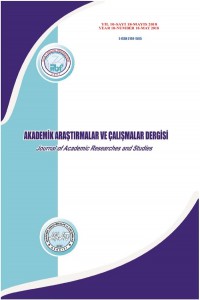DÜŞÜK FREKANSTA İNCELENEN FİNANSAL VARLIKLARIN OYNAKLIK KIRILMALARININ DEĞERLENDİRİLMESİ: BİST-100 ENDEKSİ ÜZERİNE BİR UYGULAMA
Öz
Çalışmada BIST-100 (ulusal) endeksinin 1986 yılının
birinci ayı ile 2017 yılının üçüncü ayı arasındaki aylık getiri oynaklığı modellenerek
önraporlanmaya çalışılmıştır. BIST-100 endeksinin getiri oynaklığının aylık
veriler için sabit bir değere sahip olduğu belirlenmiştir. Görsel olarak
modelin ortalamaya dönen bir yapıda olduğu saptanmıştır. Bu koşullar altında
modeldeki kırılmaların tahminlenmesi Inclan ve Tiao’nun (1994) ICSS (Yinelenen
Birikimli Kareler Metodu) algoritması ile tespit edilmeye çalışılmıştır.
Kırılmaların oluştuğu tarihler arasında seçim yapılarak modeli en iyi açıklayan
yapı seçilmiştir. Elde edilen sonuçlar karşılaştırıldığında varyansta
kırılmanın dikkate alındığı model sonuçlarının, varyansta kırılmayı dikkate
almayan model sonuçlarına nazaran gerek tahmin sonuçları gerekse öngörü
performansı açısından daha iyi sonuçlara sahip olduğu görülmektedir.
Anahtar Kelimeler
Yinelenen Birikimli Kareler Metodu Varyans Varyans Kırılması
Kaynakça
- ABRAHAM, B. and William W.S.W. (1984). “Inferences About The Parameters Of A Time Series Model With Changing Variance‟‟, Metrika, 31: 183-194.
- AGGARWAL, R., INCLAN C. and LEAL, R. (1999). “Volatility in Emerging Stock Markets”, The Journal of Financial and Quantitative Analysis, 34(1): 33-55.
- DEMİRELİ, E. ve TORUN, E. (2010). „„Alternatif Piyasa Oynaklıklarında Meydana Gelen Kırılmaların ICSS algoritmasıyla Belirlenmesi ve Süreğenliğe Etkileri: Türkiye ve Londra Örneği‟‟, Muhasebe ve Finansman Dergisi, 10(46): 129-145.
- DIEBOLD, F. (1986). „„Modeling The Persistence Of Conditional Variances: A Comment‟‟, Econometric Reviews, 5: 51-56.
- DIEBOLD, F. (1988). “Empirical Modeling of Exchange Rate Dynamics” Lecture Notes in Economics and Mathematical Systems, 303, Springer-Verlag, New York.
- ENGLE, R. (1993). “Statistical Models for Financial Volatility”, Financial Analyst Journal, 49: 72-78. ENGLE, R. and BOLLERSLEV, T. (1986). "Modelling the Persistence of Conditional Variances," Econometrics Review, 5(1): 1-50.
- FERNANDEZ, V. (2005). “Structural Breakpoints in Volatility in International Markets”, The Institute for International Integration Studies Discussion Paper Series, 76: 1-36.
- HEPKORUCU, A. (2012). „„Koşullu Değişen Varyans Modelleri ile IMKB-100 Endeksinde Varyans Kırılması Uygulaması‟‟, 1. International Symposium on Accounting and Finance, 32-48.
- HINKLEY, D. V. (1971). „„Inference in Two-Phase Regression‟‟, Taylor&Francis Group, American Statistical Association, 66(336): 736-743.
- HINKLEY, D. V. (1971). „„Inference about Change Point From Cumulative Sum Test‟‟, Oxford Journal, Biometrika Trust, 58(3): 509-523.
- HSIEH, D. (1989). “Modeling Heteroscedasticity in Daily Foreign-Exchange Rates”, American Statistical Association Journal of Business & Economic Statistics, 7(3): 307-317.
- HSU, D. A. (1977). “Test for Variance Shift at an Unknown Time Point”, Wiley, Journal of Royal Statistical Society, 26(3): 279-284.
- HSU, D. A. (1979), “Detecting Shifts of Parameter in Gamma Sequences with Application to Stock Prices and Air Traffic Flow Analysis”, Taylor Francis Group, American Statistical Association, 77(377): 29-39.
- HSU, D. A. (1982). “A Bayesian Robust Detection of Shifts in Risk Structure of Stock Market Returns”, Taylor Francis Group, Journal of The American Statistical Association, Applied Statistics, 74(365): 31-40.
- HSU, D. A., MILLER, R. B. and WICHERN, D. W. (1974). “On a Stable Paretian Behavior of Stock Market Prices” Taylor&Francis Group, Journal of the American Statistical Association, 69(345): 108-113.
- HSU, D. A., MILLER, R. B. and WICHERN, D. W. (1976). “Changes of Variance in First Order Autoregressive Time Series Model-With an Application”, Wiley, Journal of Royal Statistical Society, Series C, Applied Statistics, 25(3): 248-256.
- INCLAN, C. (1993). “Detection of Multiple Changes of Variance Using Posterior Odds”, Taylor&Francis Group, Journal of Business & Economic Statistics, 11(3): 289-300.
- INCLAN, Carla and TIAO, G. (1994). “Use of Cumulative Sums of Squares for Retrospective Detection of Changes of Variance”, Journal of the American Statistical Association, 89(427): 913-923.
- LAMOUREUX, C. and LASTRAPES, W. (1990). “Persistence in Variance, Structural Change, and the GARCH Model”, Journal of Business & Economic Statistics, 8(2): 225-234.
- MALİK, F. (2003). “Sudden Changes in Variance and Volatility Persistence İn Foreign Exchange Markets”, Journal. of Multinational. Financial. Management, 13: 217-230.
- MALİK, F. and HASSAN, S.A. (2004). “Modeling Volatility in Sector Index Returns with GARCH Models Using an Iterated Algorithm”, Journal of Economics and Finance, 28(2): 211-225.
- MANDELBROT, B. (1963). “The Variation of Certain Speculative Prices”, The Journal of Business, 36(4): 394-419.
- MENZEFRICKE, U. (1981). “A Bayesian Analysis of a Change in the Precision of a Sequence of Independent Normal Random Variables at an Unknown Time Point”, Wiley, Journal of Royal Statistical Society, Seris C, Applied Statistics, 30(2): 41-146.
- NELSON, D. (1991). “Conditional Heteroskedasticity on Asset Retuns: A New Approach”, Econometrica, 59(2): 347-370.
- POOTER, M. and DİJK, D. V. (2004). “Testing for Changes in Volatility in Heteroskedastic Time Series- A Further Examination”, Econometric Institute Report EI, 38: 1-39.
- RAPACH, D., STRAUSS, J. and WOHAR, M. (2007). “Forecasting Stock Return Volatility in the Presence of Structural Breaks”, Forecasting in the Presence of Structural Breaks and Model Uncertainty, 1-38
- RAPACH, D. and STRAUSS, J. (2008). “Structural Breaks and GARCH Models of Exchange Rate Volatility”, Journal of Applied Econometrics, 23: 65-90.
- SMITH, A., F., M. (1975). “A Bayesian Approach to Inference about a Change-Point in a Sequence of Random Variables”, Oxford University Press, Biometrika Trust, 62(2): 407-416.
- TSAY, R. S. (1988). “Outliers, Level Shifts and Variance Changes in Time Series”, Journal of Forecasting, 7: 1-20.
- WANG, P.and MOORE, T. (2009). “Sudden Changes In Volatility: The Case Of Five Central European Stock Markets”, International Financial. Markets, Institutions and Money, 19: 33–46.
- WORSLEY, K. J. (1986). “Confidence Regions and Tests for a Change-Point in a Sequence of Exponential Family Random Variables”, Oxford University Press, Biometrika Trust, 73(1): 91- 104.
Ayrıntılar
| Birincil Dil | Türkçe |
|---|---|
| Bölüm | ARAŞTIRMA MAKALELERİ |
| Yazarlar | |
| Yayımlanma Tarihi | 30 Mayıs 2018 |
| Yayımlandığı Sayı | Yıl 2018 Cilt: 10 Sayı: 18 |
Kaynak Göster
Cited By
YÜKSEK FREKANSLI TÜRK LİRASI GETİRİLERİNDE YAPISAL KIRILMALARIN BELİRLENMESİ
Journal of Research in Business
https://doi.org/10.54452/jrb.1458441
TÜRKİYE’DE BORSA, EMTİA, TAHVİL VE DÖVİZ PİYASALARI ARASINDAKİ ETKİLEŞİM: YAYILIM ENDEKSİ YAKLAŞIMI
Yönetim ve Ekonomi Araştırmaları Dergisi
Can KARABIYIK
https://doi.org/10.11611/yead.737638
Bu eser Creative Commons Atıf-GayriTicari 4.0 Uluslararası Lisansı ile lisanslanmıştır.


